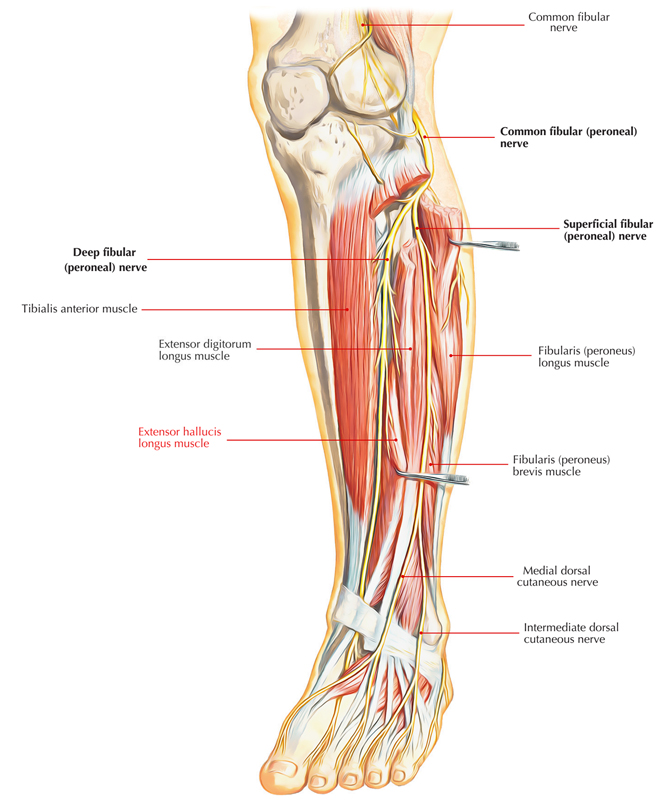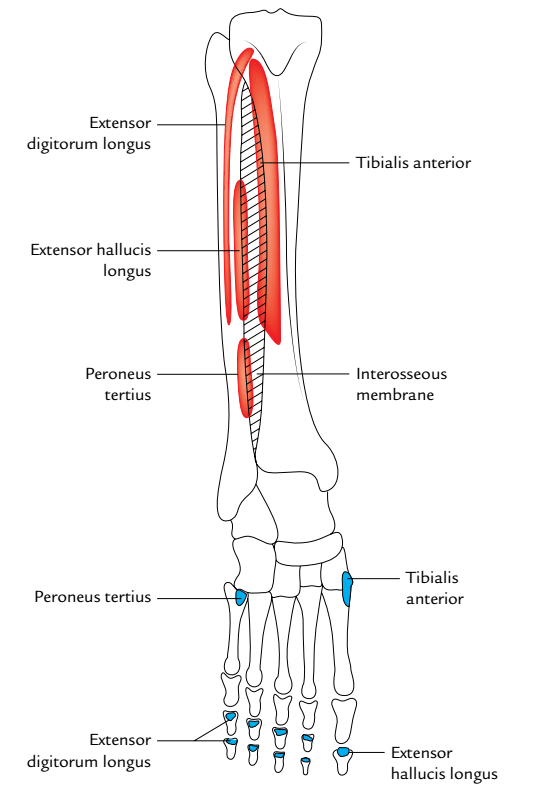The Extensor hallucis longus is a thin muscle, which is located between the Tibialis anterior and the Extensor digitorum longus, that functions to extend the big toe and dorsiflex the foot. It also help with foot eversion and inversion.
It provides the only active extension force to the interphalangeal joint and the primary active extension force to the metatarsophalangeal joint.

Extensor Hallucis Longus
Structure
The tendon of the extensor hallucis longus comes in front of the ankle joint lateral to the tibialis anterior. The tendon must be distinct plainly en route to its attachment at the proximal end of the distal phalanx of the great toe.
Origin
The Extensor Hallucis Longus originates from the Middle two quarters of the anterior surface of fibula and the adjecent interosseous membrane.

Extensor Hallucis Longus: Origin and Insertion
Insertion
The Extensor Hallucis Longus is inserted to the base of distal phalanx of the big toe.
Palpation
- The muscle belly is quickly palpated on the anterolateral aspect of the leg. Via the head of the fibula on the lateral side of the leg, simply below the knee joint, run the fingers down as well as medially for about 2 cm.
- When raising the toes off the floor, the muscle can be felt contracting. Now put the fingers over the front of the ankle joint; the tendon can be recognized being distinct plainly, is lateral to those of tibialis anterior as well as extensor hallucis longus.
- Hence the tendon can now either be trailed upwards, under the superior portion of the extensor retinaculum to sign up with the muscle belly, or perhaps descending where it separates into four specific tendons running to each of the lateral four toes.
- Each tendon rises clear of the metatarsophalangeal joint as it enters to the dorsum of the toe.
Innervation
The extensor hallucis longus muscles get their innervation by means of deep peroneal nerve sections that consist of fibers via the fourth as well as fifth lumbar along with first sacral spinal nerves.
Function
- Likewise, the extensor digitorum longus muscle, the extensor hallucis longus muscles also works as aides in controlling (slowing down) the descent of the forefoot to the floor immediately following heel-strike, thus preventing foot slap.
- Throughout the swing stage of gait, it helps in offering foot-floor clearance.
- The extensor hallucis longus is believed to assist the foot adjust to the ground in walking.
Actions
Extensor hallucis longus:
- Extends great toe.
- Dorsiflexes foot at the ankle joint.
- It also help with foot eversion and inversion.
- It provides the only active extension force to the interphalangeal joint and the primary active extension force to the metatarsophalangeal joint.
Variations
There are a variety of variations including the attachment of the extensor hallucis longus. A regular variation is the tiresome connection to the proximal phalanx creating the musculus extensor primi internodii hallucis.
Clinical Significance
Extensor hallucis Longus Injury
Any kind of strain, injury, or damage to the Extensor Hallucis Longus muscle might cause pain and reduced motion of the huge toe. It might also impact ambulation of the impacted specific making it harder for them to stroll usually.
A few of the symptoms which recommend that the Extensor Hallucis Longus muscle is strained are:
Severe pain near the top of the foot over the toes
- the impacted person might discover it challenging to raise the foot antigravity
- the patient might also feel tingling localized on the top of the foot
- the patient will feel serious pain in the huge toe
- the patient will also experience regular cramps in the foot
- There will also show up defects like hammertoes or clawtoe.
Paralysis
In the paralysis of EHL, the action of EHB is clear, the distal phalanx does not elongate and the proximal phalanx elongates in the direction of adduction.
Weak point
- Weak point of EHL deteriorate elongation at the metatarsophalangeal and interphalangeal joints.As it is the only muscle for the elongation of interphalangeal joint so weak point of it is analysis for EHL weak point.
- Throughout typical mobility, a private get in touches with the ground with the heel of the foot first. The ground response force uses a plantarflexion minute to the entire foot, which is withstood by all of the dorsiflexors. Weak point of the EHL decreases a person’s capability to manage the descent of the medial portion of the foot, especially the great toe.
- Patients with weak point of the extensor hallucis longus also report that the toe has the tendency to fold under the foot when they are pulling on socks or shoes and can trigger tripping.
Tightness
- Tightness of the EHL pulls the metatarsophalangeal joint of the great toe into elongation, which, as in the fingers and thumb, has the tendency to produce flexion at the interphalangeal joint as the flexor hallucis longus is extended, and a claw-toe defect emerges.
- Also, hyperextension of the metatarsophalangeal joint pulls the interphalangeal joint into the toe box of a shoe, triggering pain and calluses, or corns, on the dorsal side of the interphalangeal joint. Hyperextension of the great toe pulls the plantar plate distally, revealing the metatarsal visit extreme loads and producing pain.
Claw Defects
Claw defects in a foot without sensation put the person at risk of skin breakdown as the outcome of increased pressure under the metatarsal heads and in between the dorsal sides of the toes and the shoe. Claw toe defects in a foot with feeling are rather agonizing.

 (54 votes, average: 4.56 out of 5)
(54 votes, average: 4.56 out of 5)